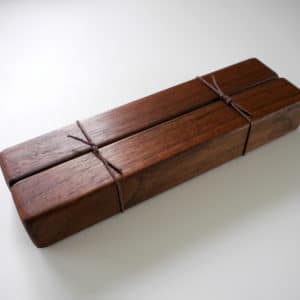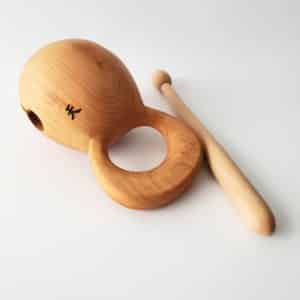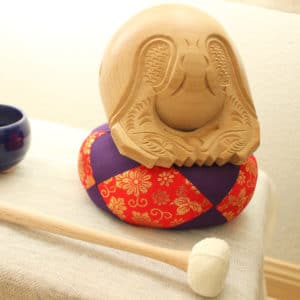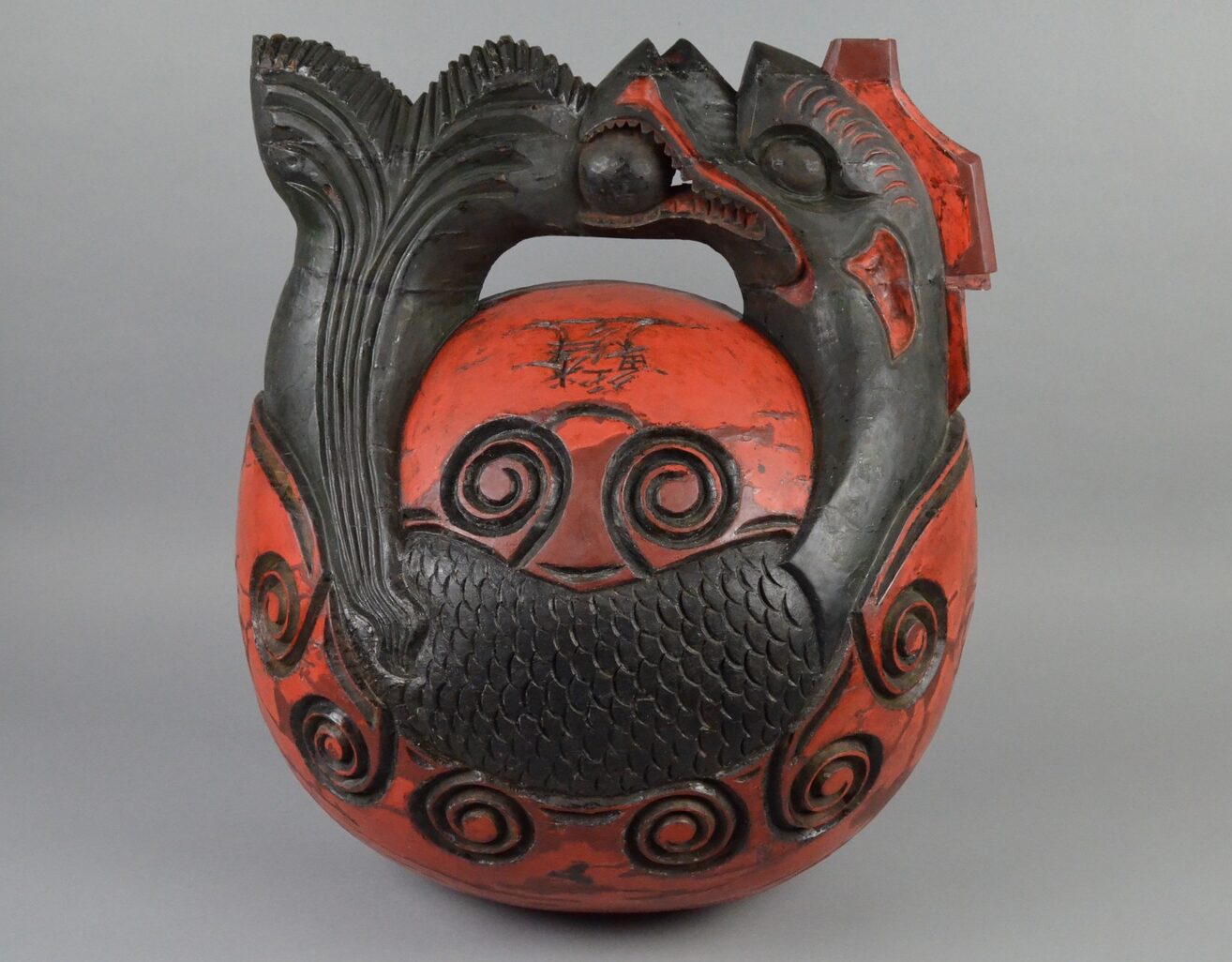
The mokugyo, also known as a “fish drum” or “wooden fish,” is a traditional percussion instrument of East Asian Buddhist traditions, including China, Japan, and Korea. The word “mokugyo” comes from the Japanese characters “moku” (木), meaning wood, and “gyo” (魚), meaning fish, which reflects its shape and material. As the name implies, the mokugyo is carved in the shape of a fish or a pair of fish facing each other.
It is typically made from a single block of wood, carved into the shape of a fish. The wood is hollowed out to create a resonant sound when struck, leaving a crescent or slit shaped opening on one side where the craftsman has used his tools. This method of construction lends another name to this style of instrument: a slit drum.
The design of the mokugyo is more than just aesthetic. The fish shape symbolizes wakefulness and vigilance, as fish are believed to never close their eyes, even while sleeping. Traditionally the fish holds a ball, symbolizing the universe, in its mouth. This serves as a metaphor for the Buddhist ideal of constant mindfulness, a key element in the pursuit of enlightenment. The mokugyo’s use in religious practice, therefore, serves as both a practical tool for timing and a symbolic reminder of the need for awareness and vigilance in one’s spiritual journey.
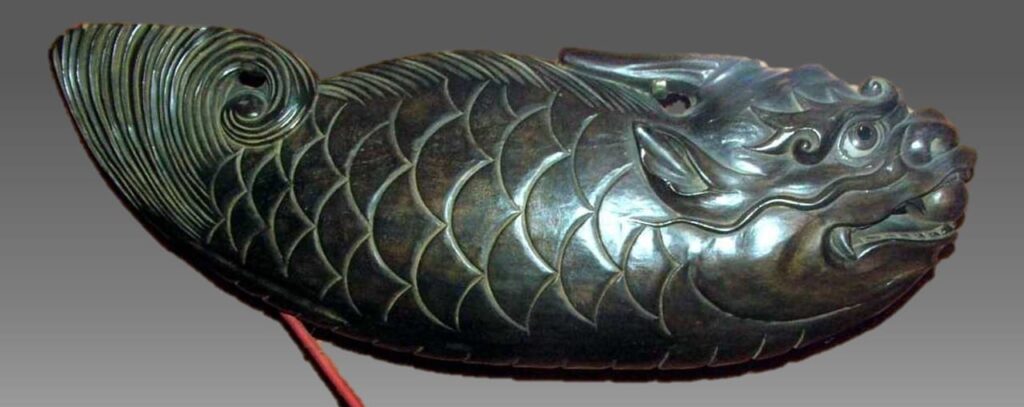
The mokugyo is most commonly used in Buddhist temples, where it plays a vital role in daily rituals. Monks and practitioners strike the drum with a mallet, creating a rhythmic, resonant sound that accompanies chanting. The steady beat of the mokugyo helps to maintain focus, synchronize group chanting, and set the pace for various ceremonies.
Crafting a fish drum
The mokugyo drum is traditionally carved from a single solid piece of wood. Durable, resonant hardwoods like cherry, camphor, or maple are preferred for its construction.
The interior is crafted to create a resonant cavity, enhancing the sound when struck. A mallet, usually with a padded head, is used to strike the drum, producing a deep, rich, and meditative tone. The construction of the striker also affects the acoustics of the drum, so both the wood of the striker as well as the material used for padding are considered when playing the mokugyo.
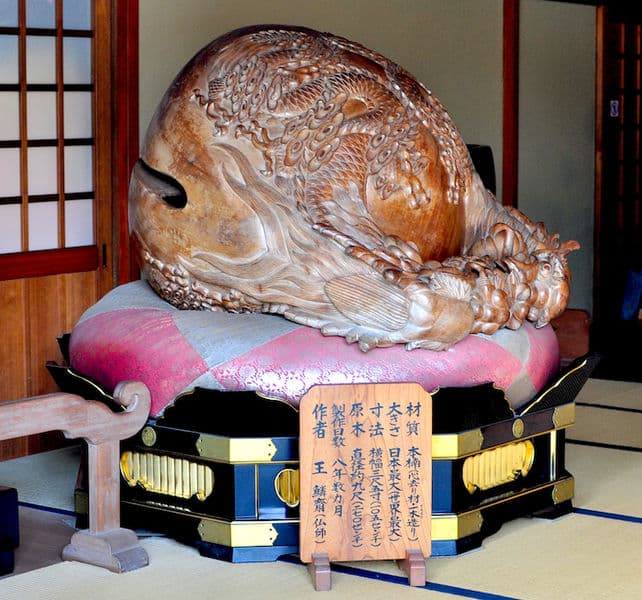
It is common for Buddhist temples to utilize multiple different sizes of mokugyo for different practices. Like other percussive instruments, the timbre, volume, pitch, and resonance of the mokugyo change with its size and material construction. It is common for a smaller, handheld mokugyo to be used in some instances. Large mokugyos, sometimes several feet in diameter, resting on top of decorative cushions are also used.
The most common style of mokugyo is rounded and more abstract, in the shape of two fishes mirroring each other with a ball held in their mouths, but more literal versions exist as well. Some mokugyos, especially smaller handheld varieties are carved to look like a realistic fish, including a tremendous amount of detail in the scales and facial expression.
During ceremonial meals in Buddhist temples, the mokugyo is often struck to signal the start and end of the meal, guiding the monks in their disciplined daily routines. In Zen practice, it is used in meditation halls to help maintain the focus and rhythm of seated meditation (zazen), ensuring that practitioners stay present and mindful throughout their practice.
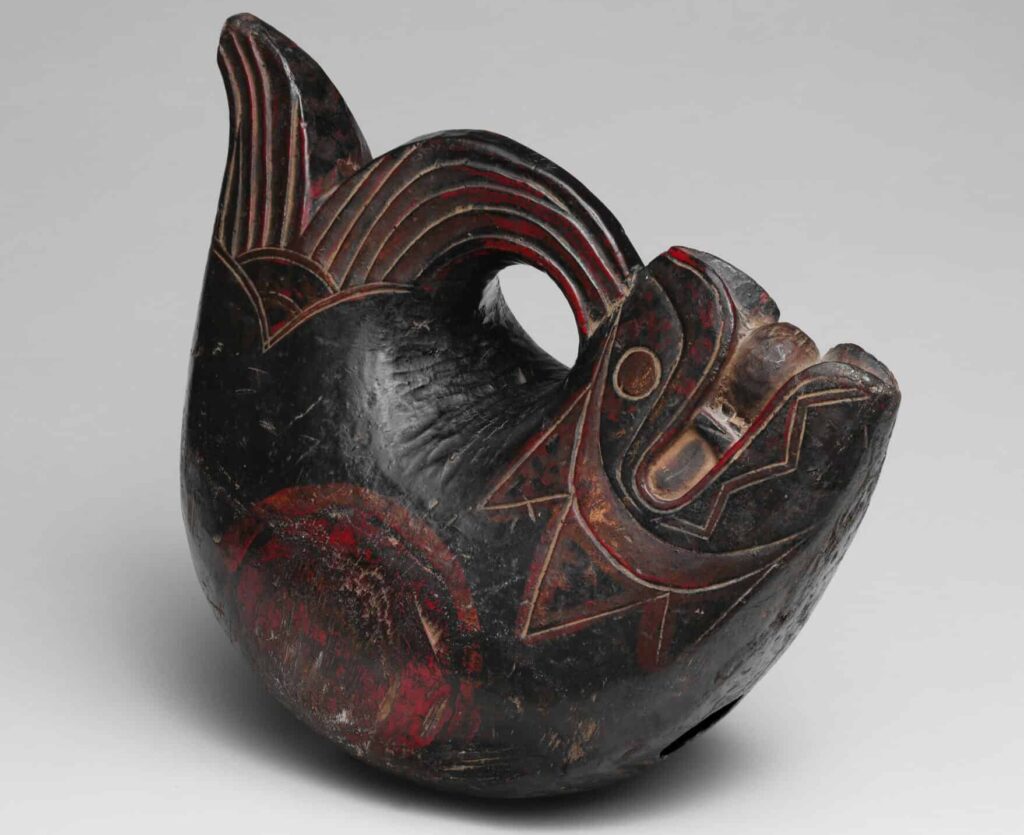
The mokugyo outside of Japan
While the mokugyo is closely associated with Japanese Buddhism, its use and significance extend beyond Japan. Variations of the mokugyo, such as the moktak in Korea and the muyu in China, serve similar roles in Buddhist rituals.
The moktak (목탁) is a wooden percussion instrument used in Korean Buddhist ceremonies. Like the mokugyo, it is struck with a mallet to produce a resonant sound that accompanies chanting and meditation. The Korean version is often smaller and more portable, allowing it to be used in various settings, from large temple halls to individual meditation sessions.
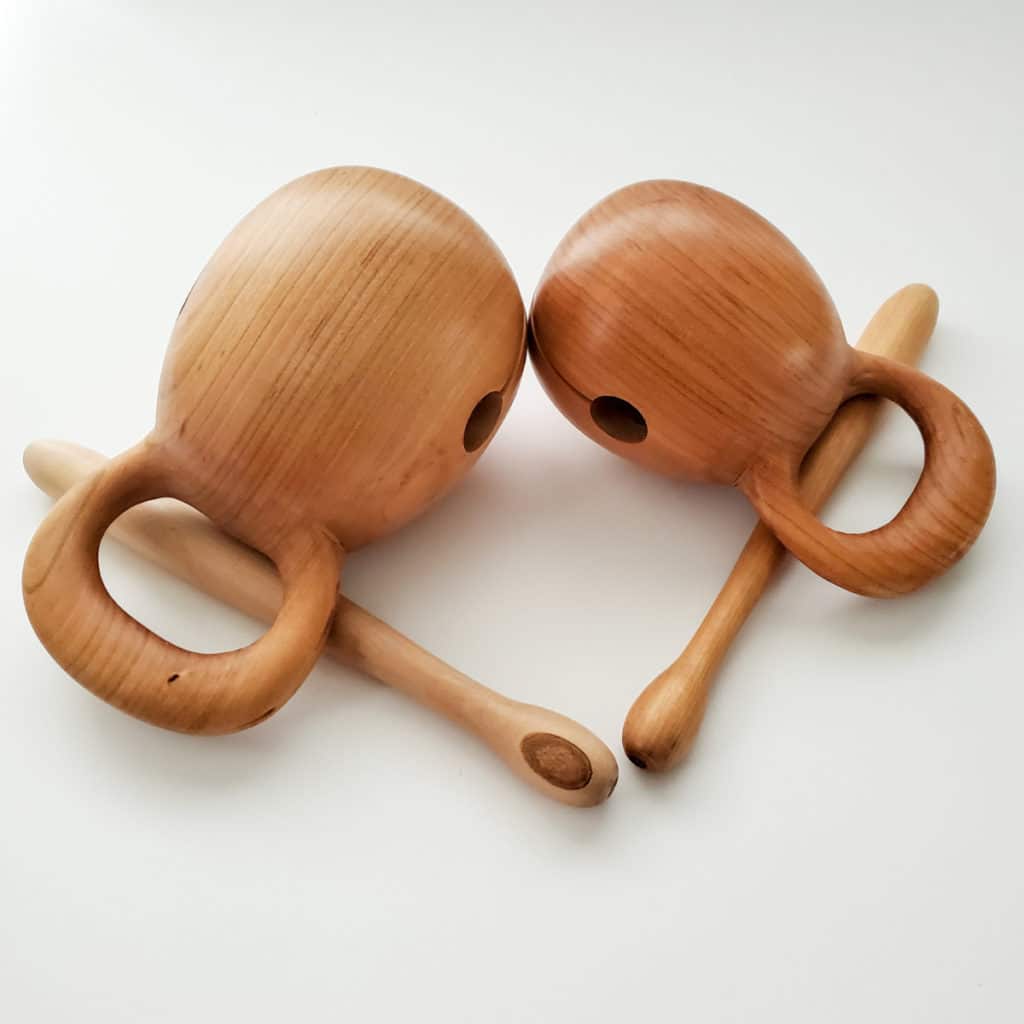
In China, the muyu (木魚), or wooden fish, is widely used in Chinese Buddhist practice. The muyu is similar in design and function to the mokugyo. It is commonly seen in temples where it accompanies chanting and recitation of Buddhist texts.
Beyond East Asia, the wooden fish drum has also gained recognition in the West. Its distinct sound and cultural significance have made it a popular tool for those seeking to incorporate traditional elements into their spiritual practices.
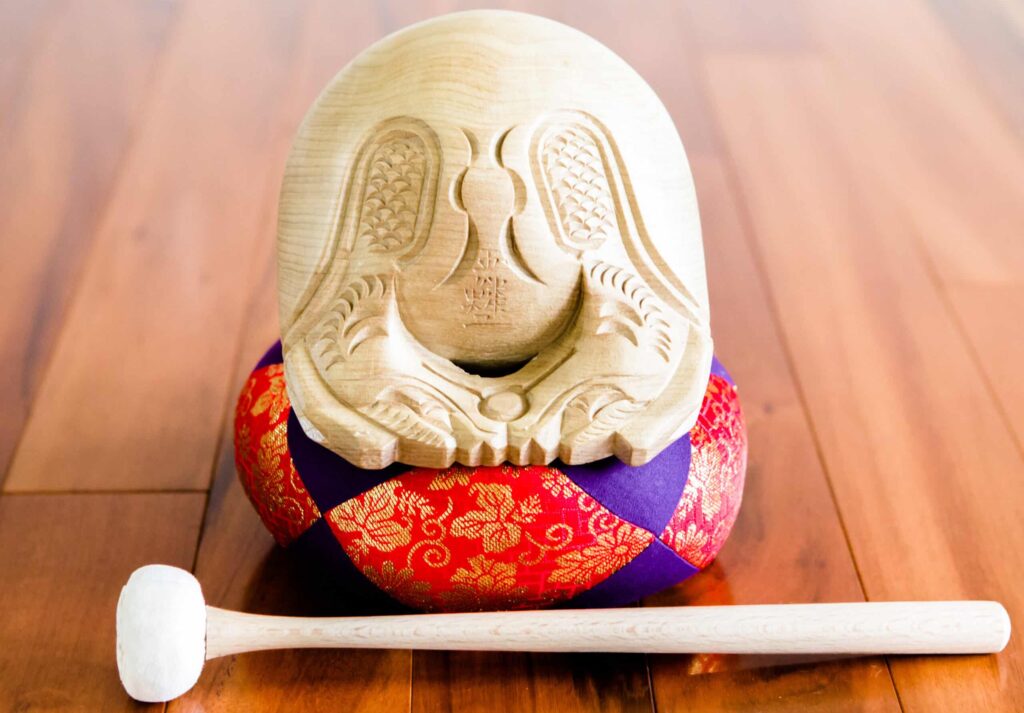
The mokugyo from Still Sitting
As Buddhist practitioners, we are proud to offer a mokugyo that we consider “the real deal.” This beautiful, authentic mokugyo is handcrafted in Japan from camphor laurelwood, the traditional hardwood favored by craftsmen. It is both aesthetically beautiful and acoustically superior to other drums on the market.
This Mokugyo has a light natural finish on it, which shows off its wood grain without paint or heavy lacquer. The striker is made from birch, and has a high quality striking head designed to produce a clear, resonant sound. The accompanying pillow is also top-quality, with a classic decorative brocade.
Further reading from the Still Sitting blog: Moktak and Chukpi: Korean instruments for meditation.
A note on our research and sources
Still Sitting is committed to writing and researching informative, engrossing, and accurate articles for our blog. We know there are many places to find information online and we work hard to ensure that we are a trusted source for all of our readers. Our blog is intended to help you to learn more about our products and the cultural and historical subjects that we hold dear. As part of this commitment, we include the sources we used to write our posts:
Acoustic characteristics of mokugyo
-
Zen Clappers$59.00
-
Product on saleMoktak Korean Drum
$189.00$169.00 -
Product on saleMokugyo Zen Drum
$265.00$239.00

